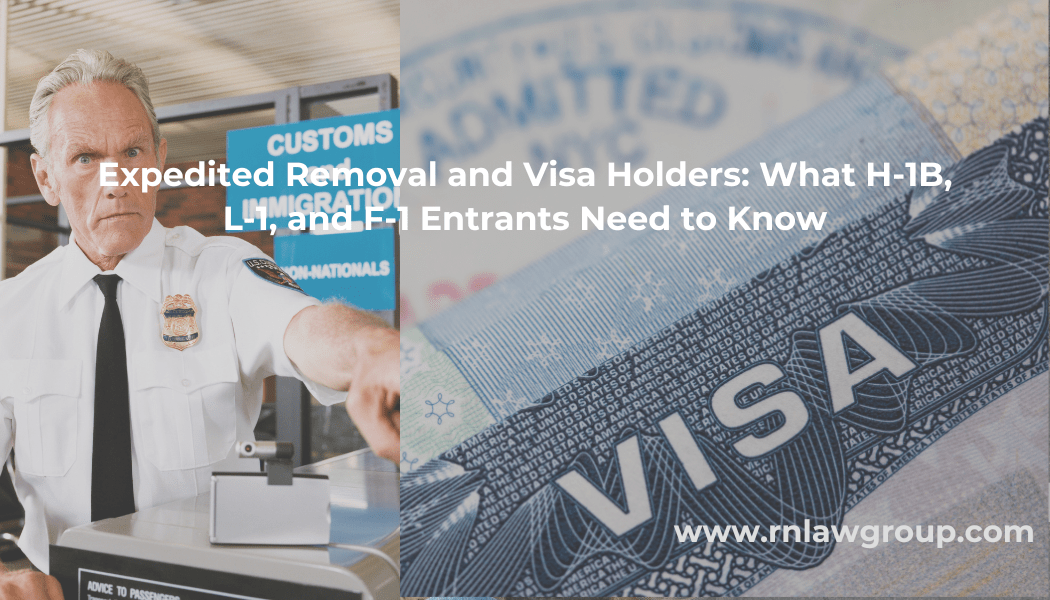
Expedited Removal and Visa Holders: What H-1B, L-1, and F-1 Entrants Need to Know
Introduction
Expedited removal is one of the most powerful enforcement tools used by U.S. Customs and Border Protection (CBP) at ports of entry. For H-1B professionals, L-1 intracompany transferees, and F-1 international students, even a routine trip to the United States can be unexpectedly cut short if CBP suspects a violation of immigration law. While H, L, and F-1 are not the only categories subject to this process, they tend to be the most common. The consequences are immediate and severe: deportation without a hearing and a multi-year bar to reentry. Understanding the expedited removal process and knowing how to mitigate risk can be crucial for travelers who rely on their visa status for employment, study, and lawful residence.
This article explores what expedited removal is, the reasons it may be applied to valid visa holders, the role of digital privacy during inspections, and what options are available after an expedited removal order is issued. We also provide practical tips for preventing issues at the border and guidance on what to expect during inspection.
What Is Expedited Removal?
Expedited removal is a process authorized by Section 235(b)(1) of the Immigration and Nationality Act (INA). It allows CBP officers to summarily remove individuals arriving at a port of entry if they are found inadmissible for certain reasons, most commonly:
- Lack of proper travel documents (INA § 212(a)(7)(A)(i)(I))
- Misrepresentation or fraud (INA § 212(a)(6)(C)(i))
Unlike traditional removal proceedings, expedited removal bypasses immigration court. The CBP officer acts as investigator, adjudicator, and enforcer. The process is swift, and there is no opportunity for a hearing or appeal before an immigration judge.
The implications of expedited removal are serious. It carries an automatic five-year bar to reentry, and if fraud is found, the individual may be permanently inadmissible to the U.S. without an approved waiver. The incident also becomes part of the individual’s permanent immigration record, visible to CBP, USCIS, and consular officers, and it may impact future visa eligibility or travel opportunities.
Why Are H-1B, L-1, and F-1 Visa Holders at Risk?
Although expedited removal was originally designed to target individuals without valid documentation (e.g., undocumented arrivals), its application has expanded and is used often by CBP officers. Today, CBP officers frequently apply expedited removal to travelers with valid H-1B, L-1, or F-1 visas if they suspect the individual is inadmissible for any of the statutory grounds and will often base their decisions on the immediate feelings during the request for admission. This shift reflects increased scrutiny of nonimmigrant visa holders and tighter border enforcement practices.
Common scenarios include:
- Misrepresentation or Fraud If a visa holder provides false information during inspection, or if CBP suspects the visa itself was obtained through fraudulent means, even if done without any knowledge by the individual, they may trigger INA § 212(a)(6)(C)(i). For example:
- An H-1B worker cannot adequately explain their job duties or identify their client.
- An L-1 transferee appears unfamiliar with the U.S. company they are transferring to.
- An F-1 student is found with documents suggesting unauthorized work.
A misrepresentation finding results in expedited removal and a lifetime bar from the U.S., unless the traveler obtains a waiver under INA § 212(i) or a 212(d)(3) nonimmigrant waiver. CBP has wide discretion in making these determinations, and even seemingly minor inconsistencies can trigger serious consequences.
- Lack of Proper Documentation Visa holders who do not carry the correct documents or whose documentation has changed may be considered inadmissible. Examples:
- An H-1B employee arrives with an old or revoked Form I-797.
- An L-1 visa holder’s petition has been withdrawn or expired.
- An F-1 student’s SEVIS record is inactive or terminated.
Even when the visa stamp in the passport is valid, issues with underlying approval notices, employer status, or SEVIS can result in expedited removal. It’s important for visa holders to confirm the validity of their supporting documents prior to travel.
- Suspected Unauthorized Intentions CBP officers may deny entry and order expedited removal if they suspect that the visa holder intends to engage in unauthorized activities. This often stems from inconsistent answers, lack of familiarity with job duties, or travel patterns that suggest intent to overstay or work unlawfully. Behavior during inspection matters; confusion, nervousness, or evasive responses can lead officers to dig deeper.
- Employer or School Under Scrutiny CBP monitors institutions that are under investigation or have a history of compliance issues. Association with a flagged petitioner or school can trigger increased scrutiny and, in some cases, expedited removal, even if the individual is personally in compliance. Visa holders should be aware of their institution’s or employer’s standing and any negative press or government notices.
CBP Authority and Secondary Inspection
At the border, CBP officers have virtually unchecked authority. Visa holders selected for secondary inspection may undergo:
- Extremely long waits
- Detailed interviews about their work or studies
- Review of documentation (I-797, I-20, DS-2019, pay stubs, client letters)
- Real-time verification of employment
- Review of SEVIS or USCIS databases
- Searches of luggage and electronic devices
Secondary inspection can last for several hours, and travelers are not entitled to legal counsel during this process. In fact, individuals are not even guaranteed the opportunity to contact a lawyer. The outcome may be admission, voluntary withdrawal of the application for admission, or expedited removal. Cooperation and preparation are critical to avoiding negative outcomes.
Digital Privacy: Searches of Phones, Laptops, and Tablets
One of the most overlooked aspects of CBP inspections is the search of electronic devices. CBP has the legal authority to inspect phones, laptops, tablets, USB drives, and other digital storage devices. These searches do not require a warrant and may be conducted even if the device is encrypted.
For visa holders, the contents of electronic devices can be the deciding factor in an admissibility decision. CBP officers may:
- Review emails and text messages for signs of unauthorized employment
- Examine resumes, job applications, or LinkedIn profiles
- Look for discrepancies between the stated purpose of entry and digital records
- Scrutinize social media activity and web browsing history
Even documents that appear innocuous can be interpreted as evidence of intent to violate visa terms. For example, a graduate student with CPT authorization might still face questions if CBP finds documents suggesting full-time employment without approval.
Travelers should be aware that digital content may be misinterpreted or taken out of context. Devices should be cleaned of unnecessary data and cloud accounts should be logged out before travel. For detailed strategies on how to minimize risk, see our related article: Your Phone, Your Data: How to Safeguard Your Digital Life When Entering the U.S..
Consequences of Expedited Removal
Being subject to expedited removal has immediate and lasting consequences:
- Deportation: You are placed on the next available flight out of the U.S., often within hours.
- Visa Cancellation: CBP will physically cancel the visa stamp in your passport, rendering it invalid.
- Reentry Bar: You are barred from reentering the U.S. for five years under INA § 212(a)(9)(A)(i).
- Permanent Inadmissibility: If misrepresentation is found, you are permanently inadmissible under INA § 212(a)(6)(C)(i).
- Public Record: The removal is entered into DHS and DOS databases and will be visible during future visa applications, potentially raising red flags in any future petition or consular interview.
What Can You Do After Expedited Removal?
Although there is no formal appeal process, several avenues exist to address an expedited removal order:
- File a DHS TRIP Redress Request Through the Department of Homeland Security Traveler Redress Inquiry Program (DHS TRIP), individuals can request corrections to their records. This is often used to clarify the record for future travel but may not reverse the removal order itself. It can be helpful for travelers with repeated issues at ports of entry.
- Apply for Permission to Reapply (Form I-212) If a traveler wishes to return to the U.S. before the five-year bar expires, they may apply for permission to reapply using Form I-212. Approval is discretionary and requires a strong showing of rehabilitation, purpose of travel, and equities in the applicant’s favor. Employers or family members in the U.S. may also support this application. Note, this is discretionary and up to CBP whether they want to grant it or not.
- Seek a 212(d)(3) Nonimmigrant Waiver For those subject to a fraud-related inadmissibility ground, a 212(d)(3) waiver may be required even after the five-year bar. This waiver must be recommended by a consular officer and approved by CBP headquarters. It is often used in conjunction with a visa application and can allow a one-time entry despite the inadmissibility. Like the I-212, this is discretionary and can be denied for any reason. Note, for Canadian citizens, the waiver will be done through an I-192.
- Wait Out the Bar In some cases, the most practical option is to wait until the five-year bar expires and reapply for a visa. However, the prior removal will remain on record and can affect future adjudications. Being transparent in future applications and explaining the situation honestly is essential.
Tips to Avoid Expedited Removal
- Carry all original approval notices and employment verification documents.
- Know the details of your visa petition, job duties, worksite, and employer.
- Ensure your SEVIS record is active and updated.
- Be honest and consistent during inspection.
- Minimize data on personal devices and consider travel privacy best practices.
- Practice responses to basic questions about your job or academic program before travel.
- Keep a list of emergency contacts, including legal counsel.
Conclusion
Expedited removal is a harsh enforcement mechanism that can impact even well-meaning, compliant visa holders. For H-1B, L-1, and F-1 travelers, preparation is key. By understanding the reasons CBP may invoke expedited removal and taking proactive steps to avoid red flags — including securing your digital privacy — you can better protect your ability to enter and remain in the U.S.
If you or someone you know has been subject to expedited removal, consult an experienced immigration attorney to assess next steps, including potential waivers and future admissibility. A proactive legal strategy can help turn a major setback into a recoverable situation. Navigating this complex area of law with proper legal support can make all the difference in preserving your long-term immigration goals.
Reddy Neumann Brown PC located in Houston, Texas, has been serving the business community for over 25 years and is Houston’s largest immigration law firm focused solely on U.S. Employment-based and investor-based immigration. We work with employers, employees and investors helping them navigate the immigration process quickly and cost-effectively.
By: Steven Brown
Steven A. Brown is a Partner at Reddy Neumann Brown PC, where he leads the firm’s Litigation Team, addressing delays and denials of immigration benefits, FOIA requests, and policy and regulatory challenges. Steven is dedicated to delivering practical and effective solutions for clients facing unreasonably delayed or unlawfully withheld immigration benefits, including Employment Authorization Documents (EADs), advance parole, green cards, 221(g) decisions, EB-5 delays, and other immigration-related matters. His litigation efforts were instrumental in Shergill, et al. v. Mayorkas, a landmark case that led to the U.S. government recognizing that under the INA, L-2 and E visa spouses are authorized to work incident to their status, eliminating the need for separate EAD applications. This case has transformed work authorization for thousands of families across the United States.

